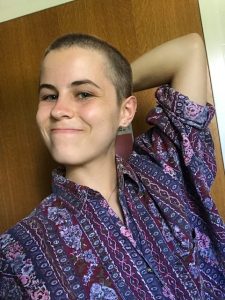By Paisley Hansen

Hello! My name is Paisley, and I’m an intern with Art Spark Texas. Something that’s been on my mind recently has been the question of representation – not just who gets representation, but how are they being represented?
Even while queer orientations continue to gain representation and acceptance, asexuality often remains stigmatized and misunderstood. As with any identity, people can have different interpretations of what asexuality means to them, but in general someone who is asexual does not experience sexual attraction. A study published in 2012 demonstrated that attitudes towards asexuals are more negative than those towards other sexual minority groups. It was even found that those who identify as asexual are seen as less human because of their asexuality.
People with disabilities are often dehumanized. Desexualization is just one dimension of this dehumanization that these individuals face from society. Recognizing a person’s sexuality first demands that you recognize them as a person with their own agency. And so, because of misconceptions towards disability, people sometimes assume that there is an association between asexuality and disability– that individuals with disabilities must be asexual, and/or that asexuality itself only exists as a symptom of disability.
Amaranthe Rae Zinzani is a medical editor and writer who is both asexual and Autistic. In an interview with Ace Week she speaks about experiences in which people have told her she is only asexual because of her autism – an assumption that is based in stigmas towards both asexuality and disability. She explains how this “pathologizes asexuality.” Zinzani also speaks about the desexualization of people with disabilities, and how this is an example of how society infantilizes these individuals.
It is understandably hurtful for a person to be told that their sexuality is a disorder, because this doesn’t reflect positively on what it means to be asexual or disabled. The association between asexuality and disability is founded on the negative stigmatization of both these identities. Zinzani recognizes that there are some whose sexuality or gender identity is influenced by their disability, but emphasizes that while these individuals are entirely valid in their identities, that doesn’t mean that their experiences can be generalized to all asexuals with disabilities. To suggest that asexuality is a symptom of a disability is meant to delegitimize it as an identity, and to assume that a person with a disability must be asexual is a method of dehumanization. Either way, the implication is that there is some standard of what it means to be a ‘normal’ person, and both asexuality and disability go against these stereotypes of what society readily accepts as normal.
People need to broaden their ideas of what it means to be disabled or asexual – all kinds of different people have disabilities, and all kinds of different people identify as asexual. Both of these identities can be misconstrued as deficiencies, but this misconception only stems from certain people assuming that their experiences are universal aspects of life because it’s what they’re familiar with – such as feeling sexual attraction, or living in a non-disabled body. If we as a society could better respect both asexuality and disability as legitimate identities, there would no longer be this false association between the two. Then more people would be able to see the experiences of being asexual or having a disability for what they really are– ordinary elements of life for ordinary people.
Paisley studies Linguistics and French at Bennington College, and helps out in art classes at the Village School of North Bennington. She was drawn to Art Spark Texas after spending the summer in Saint Paul as an Inclusion Facilitator, where she worked one-on-one with youth with disabilities to support them every day at camp. For her internship this winter she’s helping with the Go Project classes each week, assisting with creating a pair of volunteer orientation videos, and working on developing a curriculum to bring together diverse age demographics through recipes and storytelling.
